TOYOTA
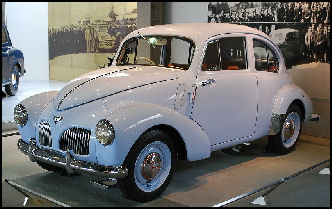
1947 Toyopet Toyota Motor Company is the world’s biggest automobile maker in terms of market value and sales. It is regarded as the world's most efficient car manufacturer as well as one of the world's best run companies.
Toyota is headquartered and has its oldest plants in Toyota City, a suburb of Nagoya previously known as Koromo. Toyota has 250,000 workers scattered around the world. It employs a domestic, regular workforce of 66,000 people at 12 plants, with 90 percent of them in the Nagoya area.
Toyota is truly a global automobile giant. It makes cars in 52 plants in 26 countries and regions and sells them in 160 countries, racking up annual global sales of more than $200 billion and has traditionally made about 70 percent of its profits in North America. The Toyota Group includes small-car-maker Daihatsu Motor Co. and truck-maker Hino Motors. Toyota is one of the largest holders of Panasonic stock.
In July 2011, Toyota was ranked the world’s No. 1 “Global Green Brand” by New-York-based Interbrand. In October 2011 Toyota retained 11th place in the Interbrand Best Global Brands ranking. Coca Cola and IBM were No. 1 and 2. In August, Toyota’s Lexus and G.M.’s Cadillac topped the Japanese Customer Satisfaction Index’s annual ranking of automakers. Toyota itself was the only nonpremium brand in the top five.
In 2007, Toyota marked it’s 70th anniversary as an auto company and 50th year selling cars. That year it ranked 2nd on Fortune’s list of most admired companies and 12th on the Forbes magazine corporate ranking list. According to a 2006 Harris poll Toyota was the 4th best brand after Sony, Dell and Coca Cola.
In 2007, Toyota moved up to 6th on the Fortune 500 list of the world’s 500 largest companies, up from 8th the previous year. With $204.75 billion in revenues in 2006 it was the only Asian company to make the top 10.
Toyota has more models on the road than any other automobile maker and has more than 50 plants worldwide. About 80 percent of all the Toyotas sold in the United States in the last 20 years are still on the road today.
Websites and Resources
Good Websites and Sources: Toyota toyota.com ; History of Toyota toyota.co.jp/en/history ; Toyota Automobile Museum toyota.co.jp/Museum ; New York Times articles on Toyota nytimes.com ; Car Connections on New Toyotas thecarconnection.com/make/new,toyota ; Toyota factory tour Japan Guide and Toyota site ; Toyota Motorsports toyotaracing.com/ ; Toyota Robots toyota.co.jp/en/special/robot ; Toyota Concept Cars toyota.com/concept-vehicles ; Book: “The Elegant Solution: Toyota’s Formula for Mastering Innovation” by Matthew E. May (Free Press, 2006)
Hybrids and Electric Cars Wikipedia article on Hybrids Wikipedia ; Toyota Hybrids toyota.com/hybrid ; Wikipedia article on Electric Cars Wikipedia ; All Electric Cars Blog allcarselectric.com ; Toyota Electric Cars allcarselectric.com/blog ;
Links in this Website: INDUSTRIES IN JAPAN Factsanddetails.com/Japan ; JAPANESE COMPANIES Factsanddetails.com/Japan ; TRADE AND OVERSEAS BUSINESS IN JAPAN Factsanddetails.com/Japan ; MACROECONOMICS IN JAPAN Factsanddetails.com/Japan ; JAPAN INC. AND REFORMS Factsanddetails.com/Japan ; JAPANESE AUTOMOBILE INDUSTRY Factsanddetails.com/Japan ; AUTOMOBILES AND DRIVING IN JAPAN Factsanddetails.com/Japan ; HYBRIDS, FUEL CELLS AND ELECTRIC CARS IN JAPAN Factsanddetails.com/Japan ; JAPANESE AUTOMOBILE COMPANIES Factsanddetails.com/Japan ; TOYOTA Factsanddetails.com/Japan ; TOYOTA PRODUCTION AND WORKERS Factsanddetails.com/Japan ; TOYOTA PROBLEMS Factsanddetails.com/Japan ; TOYOTA CARS, RACING AND ROBOTS Factsanddetails.com/Japan ; HONDA Factsanddetails.com/Japan ; HONDA CARS, PLANES, ROBOTS AND RACING Factsanddetails.com/Japan ; NISSAN Factsanddetails.com/Japan ;
Good Websites and Sources on Industry: Good Photos at Japan-Photo Archive japan-photo.de ; Companies Listed by Industry mizuho-sc.com ; Ministry of Economy, Trade and Industry meti.go.jp/english ; Statistical Handbook of Japan Manufacturing Chapter stat.go.jp/english/data/handbook ; 2010 Edition stat.go.jp/english/data/nenkan ; News stat.go.jp
Toyota Success

2010 Prius Toyota has traditionally seen itself as company with a social responsibility to its customers and employees with profits and growth being a byproduct of these values but ultimately secondary concerns, Honorary Chairman ShoichiroToyoda once remarked, “Since when do we follow figures?”
Toyota earned $15.1 billion in profits in 2007 — more than GM's entire market capitalization of $10 billion.
Toyota is gearing itself up to eventually take 20 percent of the world market which would give it a comfortable lead over GM, which had a 15 percent share of the world market before it declared bankruptcy during the global financial crisis in 2008 and 2009.
Toyota has been the worlds No. 1 automaker in terms of market value for some time. Its market capitalization in 2005 was $177 billion, more than the next three carmakers combined.
Toyota posted an operating profit of ¥2.24 trillion in fiscal 2006. It was the first Japanese company to surpass ¥2 trillion mark (about $20 billiom). Toyota doubled its profits in the previous five years. In fiscal 2003-2004 it earned ¥1.16 trillion (about $11 billion) in profits. It was the first time a Japanese company ever earned more than ¥1 trillion and was more than General Motors, Ford and Daimler earned combined.
Toyota has achieved its great success mainly due to strong sales in North America and Asia. As well as making itself and its investors rich, Toyota has also enriched its suppliers.
Toyota Versus GM
Toyota sold 7.56 million units in 2008-2009, more than General Motors, to become the world’s largest automaker in terms of sales. Toyota sold 1.34 million less vehicles than the previous year but did less poorly than GM, which declared bankruptcy and was bailed out by the U.S. government in 2009.
Toyota sold 8.42 million vehicles globally in 2010, enabling it retain its ranking as the world’s top automaker for the third straight year. No.2 GM sold 8.39 million vehicles.
In 2007 Toyota surpassed GM in global vehicle production but fell slightly behind GM in global sales. Toyota made 9,497,754 vehicles in 2007, up 5.3 percent from 2006, beating GM which produced 9.284 million vehicles. GM sold 9,369,524 vehicles, compared to 9.366 million for Toyota. Even though GM won in the sales category it was closing down plants while Toyota was expanding.
In the first three months of 2007 Toyota outsold GM with Toyota in global sales by selling 2.36 million vehicles to GM’s 2.26 million It was the first time Toyota beat GM n a quarterly basis.
GM had held the No. 1 position in production since 1931. In 1997 GM sold 8.5 million vehicles compared to less than 5 million for Toyota. The record sales for vehicles in 9.55 million by GM in 1976.
Toyota Falters After Safety Problems and Tsunami
Sales fell 7.7 percent in fiscal 2009-2010. Sales of Toyota vehicles fell behind GM and Ford after the earthquake and tsunami in 2011 in the United States as parts shortages and Toyota production cuts hurt sales. Toyota said its sales target for 2011 is 7.7 million vehicles. It hopes to sell 10 million units by 2015.
Toyota fell to 360th place from 3rd place the previous year in the Forbes ranking of the world’s leading companies in 2010. Around the same time Moody downgraded Toyota over uncertainty of “product quality.”
Still Toyota made a group net profit of about $5.7 billion and a group operating profit of about $6.5 billion in fiscal 2010-2011 on about $210 billion in sales, It marked up these numbers even though sales dropped and profits dived 77 percent in forth (January to March) quarter because of a drop in domestic sales and production problems associated with the March 11 earthquake and tsunami. Toyota, including Daihatsu and Hino, sold 7.31 million vehicles globally up from 7.24 million the previous year and sold 5.07 million vehicles overseas up from 5.07 million the previous year. Daihatsu made a group net profit of about $620 million and a group operating profit of about $1.2 billion in fiscal 2010-2011 on sales of $1.8 trillion.
Toyota said its sales target for 2011 is 7.7 million vehicles. It hopes to sell 10 million units by 2015. How well the company does in achieving this goal is reached largely depends how well Toyota does in emerging markets such as China, India, Brazil and Russia.
GM Retakes Title from Toyota as World’s No. 1 Automaker
General Motors Co. has retaken the title of world's top-selling automaker, selling just over 9 million cars and trucks around the globe, AP reported. The company said that it sold 9.03 million vehicles worldwide last year, up 7.6 percent from 2010. That's more than 1 million better than Japan's Toyota Motor Corp., which took the title away from GM in 2008. GM also beat Germany's fast-growing Volkswagen AG, which last week reported record global sales of 8.16 million in 2011, up 14 percent from the year before. Toyota said it sold 7.9 million vehicles worldwide last year. [Source: AP, January 21, 2012]
“GM had held the global sales crown for more than seven decades before losing it to Toyota as GM's sales tanked while it headed toward financial ruin. In 2009, GM filed for bankruptcy protection, needing a US government bailout to survive. Now GM is profitable again and its vehicles are selling well across the globe. The company reported net income of $7.1 billion for the first three quarters of last year, and it is expected to add to that number when it reports fourth-quarter and full-year results in February.
“Toyota is aiming for a comeback this year and has predicted that it will sell 8.48 million vehicles in 2012. Its sales were hurt last year because the March earthquake in Japan slowed its factories, and dealers ran short of cars to sell.Auto industry analysts predict a tight race this year between GM, Volkswagen, Toyota and the joint venture between Nissan and Renault.
“Some analysts have said that VW is the world's biggest automaker because GM's figures include vehicles made by its Wuling joint venture in China. Many don't count Wuling because GM doesn't have controlling interest in the company, but GM includes it in global sales figures. Excluding Wuling, GM would have been topped by Volkswagen.
Toyota Reaches 200-Million Vehicle Milestone in 2012
In July 2012, Toyota and Motor Trend announced: “As of the end of June, worldwide Toyota sales have surpassed the 200-million-unit mark since the first Model G1 truck rolled off the assembly line in August 1935. During the ensuing 76 years and 11 months, the automaker has produced approximately 145.21 million vehicles in Japan and another 55.12 million units overseas. That balance is likely to shift as expensive production costs in Japan force Toyota to start making vehicles like the Lexus RX 450h elsewhere. [Source: Jason Udy, Motor Trend, July 25 2012, Toyota]
“The 50-million-vehicle milestone happened in October 1985, taking more than 50 years to produce, according to Toyota. The next 50 million units were reached 11 years later, in January 1997. Nine years later, Toyota’s overall production hit 150 million. If that wasn’t quick enough, the final 50 million units were produced in about 6.5 years.
“The Model G1 truck was built by Toyoda Automatic Loom Works Ltd.’s Automotive Department, before becoming Toyota Motor Corporation. Not surprisingly, the Toyota Corolla is the highest produced model — one out of every five Toyotas ever sold have been Corollas. While Toyota may have needed about 77 years to reach 200 million units, we’re guessing it won’t take nearly that much time to double that figure.
Early History of Toyota
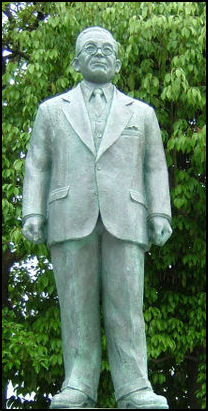
Kichiro Toyoda In 1933, Kiichiro Toyoda founded the company that would later became the Toyota Motor Company. It began as a divisions within a textile company called Toyoda Automatic Loom Works. Toyota is a slight alteration of the Toyoda name. [Source: Time magazine]
Why is Toyota used as the company name instead of Toyoda? The company name Toyoda was used in the early days but was changed to Toyota in 1935 as a brand name for export vehicles. This was done because Toyota was easier for foreigners to pronounce and typing it required eight katakana strokes instead of 10 for Toyoda. Eight is a lucky number in Asia.
Kiichiro's father, Sakichi Toyoda (1867-1930), a chain smoking carpenter and inventor, invented a power loom in 1898 that automatically stopped when a thread broke. This revolutionized the textile business by allowing a single worker to work several looms and laid the foundations for establishment of the family textile business.
The £100,000 that Sakicho received from a British company in 1929 for the rights to the revolutionary loom was used to launch an automotive department at Toyoda Automatic Loom Works. Sakichi told his son Kiichiro, "Build a Japanese car by Japanese hands.” At that time Ford and General Motors were making cars in Osaka.
Eiji Toyoda
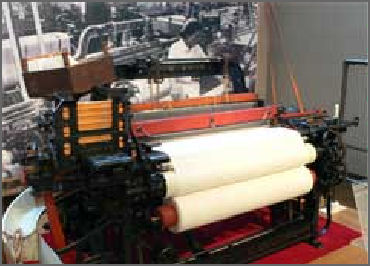
Toyota loom Eiji Toyoda (1913- ) is considered the father of the Toyota Motor Company. A cousin of Kichiro and a nephew of Sakichi, he was the president of Toyota from 1967 to 1982, when the company experienced it greatest growth, and remained on the Toyota board until 1994. He was the second Japanese to be inducted into the U.S. Automotive Hall of Fame after Soichiro Honda.
Eiji Toyoda was born near Nagoya. He spent much of his youth in his father's textile mill. Recalling those days he wrote in his memoir, "machines and business were always there right in front of me. I probably developed an understanding of both."
Pushed by his uncle Sakichi, Eiji entered Tokyo Imperial University to study engineering. After graduation he began working for his family’s company and was but in charge of setting up a research laboratory in Tokyo and hiring top notch engineers to join him. After that was put in charge of machinery and production planing in the company’s factory.
Book: “Fifty Years in Motion”, Eiji Toyoda's memoir, was published in 1987.
Toyota Before and During World War II

Toyoda jeep Toyota got its start in the car business by reverse engineering GM and Ford cars The Toyoda Automatic Loom Works’s first car engine, built in 1934, was a copy of Chevrolet engine that was so exact, Chevrolet parts could be attached it.
By 1936, Kiichiro was developing the “kanban” ("just in time") manufacturing system and laying out an assembly line with tools grouped along the flow of production, which meant that the supply line was shorter and parts could be delivered to the assembly line quicker.
Toyota Motor Company was formally established in 1937 as a spinoff of Toyota Automatic Loom Works. The first Toyota passenger car went into production in 1936 but the project was shelved after the Japanese government demanded tricks for the war effort. At the time of the Pearl Harbor attack, Toyota was making 1,000 trucks a month. As the war progressed supply lines were cut and production declined and shortcuts had t be taken. At the end of the war Toyota trucks had only had rear breaks and a single headlight.
On the day before the war ended, American bombers destroyed a quarter of a new Toyota plant. A full scale bombing raid, intended to take place a week later, had the objective of destroying the entire plant but never took place. After the war, Toyota was forbidden from making vehicles and the company made preparations to make chinaware and fishpaste.
Toyota After World War II

early Toyota car Not long after World War II was over, Toyota was asked to produce trucks and buses as part of an efforts to get the Japanese economy back on its feet. The company had no problem filling orders for trucks but it did have problems getting paid for them and nearly went bankrupt.
To escape from it financial trouble and growing discontent among its workers, Eiji established a new company, the Toyota Motor Company, whose it initial object was not to make the cars but to take orders, deliver vehicles and collect payment. This arm of the company operated independently from the manufacturing arm until they were united in 1981.
In 1950, Toyota was producing 40 vehicles a day. A trip to the United States by Eiji awakened him to the potential of large-volume production. He told his colleagues he didn't see anything the Americans were doing that his company couldn't do.
Toyota Makes Cars

1963 Publica Back in Japan, Eiji worked with Toyota’s production specialist, Taiichi Ohno, to develop new production techniques that allowed Toyota to make cars in small batches more efficiently than big companies could. To avoid waste, small supplies of parts were brought to the line frequently and parts and supplies were ordered as they were used in accordance with the kanban system.
In 1955, Toyota began making the Crown, it first domestically-produced car and one of the first full-scale production model to be sold in Japan. The Crown sold well in Japan, where there wasn’t much homegrown competition.
A 1.5-liter Crown went on sale in California in 1957. It and other early Japanese cars had a reputation for breaking down. The Crown debut was a disaster. It was withdrawn from the American market in 1960 in part because of its poor performance: it was incapable of maintaining high speeds on American highways and was prone to overheating.
To showcase Toyota durability a Crown was taken on a 50,000 kilometers trip from London to Tokyo. The trip didn’t make much of a difference in sales but ir did improve the image of Japanese cars,
In the early 1960s, Toyota produced the Corona. In 1966, it produced the Corolla. It was a big success and has gone on to be one of the bestselling cars of all time.
Early Toyota Success

early Corolla Toyota exports increased gradually reaching 1 million in 1969. The company like other Japanese carmakers was helped by the Energy Crisis in the early 1970s.
A turning point for Toyota came in 1984 when it and General Motors began to build vehicles together in the United States. The move was made in response to trade friction between the United States and Japan, the appreciating yen and to defray criticism that Japanese automakers were taking too large a share of the American market. The success of the alliance encouraged. Toyota to expand overseas production. It opened plants in Southeast Asia and western Europe and now has 52 plants n 26 countries and regions.
The Corolla compact sedan was periodically redesigned after it was launched in 1966. New models were launched in 2000 and 2006. Referred to as “Toyota’s bread and butter,” it has accounted for a fifth of Toyota’s sales over the years. In 2006 it was the best-selling car in Japan for the forth year in a row, selling 143,176 units. It sold 163,181 units in 2004
Toyota expanded its domestic plants and claimed mantel from Nissan of Japan’s largest carmaker by a large margin. In Japan today, Toyota is known for making high-quality but stodgy cars. It sold about 1.35 million cars in Japan in 2000, compared to almost 1.8 million in 1995.
Toyota sold more than 5 million vehicles for the first time in 1998 and grabbed a 10 percent stake of global automobile sales for the first time in 2002 . It increased sales by about a half million a year between 2003 and 2007, selling 6.73 million vehicles worldwide in 2003, 7.36 million vehicles in 2005, 9.02 million in 2006 and 9.366 million in 2007. .
In 2004, Toyota sold 7.47 million vehicles worldwide. It became the No.2 car maker in the world .behind GM which 8.99 million vehicles and leapt ahead of No 3 Ford, which sold 6.79 million units. In 2006 Toyota increased production in the United States, Thailand and eastern Europe to keep up with demand.
Green Toyota?

2010 Tundra Toyota is the largest maker of hybrid gasoline-and-electric-powered vehicles. It rolled out the Prius — its highly successful and famous hybrid — at the Kyoto Global Warming Conference in December 1997. The auto world was stunned as it was it not a concept car slated to be introduced in the distant future but was a vehicle already in production and ready to be sold.
As part of its effort to be more environmentally-minded in its production, Toyota is taking carbon dioxide and “waste” heat from natural gas to make electricity and using Asia’s largest greenhouse, which covers 20,000 square meters, to grow potted flowers. Toyota has also built one of the world’s largest solar energy generation systems at its Tsutsumi plant with a total generating capacity of 2,000 kilowatts.
In recent years Toyota has come under for building more profitable but wasteful gas-guzzling SUVs and pick-ups and seeking government support for such vehicles. The Sierra Club called Toyota a “hypocrite” for siding with Detroit in opposition to tougher new gas-mileage laws. It joined the Detroit in a lawsuit against California over legislation to to reduce global-warming gases from cars by 30 percent by 2015, and, unlike Honda and Nissan, sided with Detroit against proposals by Congress to raise minimum fuel economy standards from 25mpg to 35 mpg. For taking these positions Toyota became the target of protests and letter-writing campaigns by environmental groups.
Toyota Business

Toyota headquarters Toyota holds tens of billions of dollars in cash, bonds and shares in other companies. As of 1999, the only major Japanese companies without major foreign investors were Toyota and Honda.
Large cash reserves gives Toyota lots of money for large investments, research and the production of many models.
Toyota did not make foolish investments in the Bubble Economy period in the 1980s. Its profits were lower than they could have been in the mid 2000s as the company invested its large amounts cash in projects to ensure growth in the coming decades.
American workers earn $25 an hour at Toyota factories in Georgetown Kentucky and East Liberty Ohio. Toyota has gained advantage over Detroit by offering health car more cheaply and efficiently than American carmakers. Because Toyota has been around a relatively short time in the United States it doesn’t have as many retirees and pensions to pay.
In 2004, Toyota announced it was entering the securities brokerage business, selling investment, trust, bonds and other financial instruments. Around the same time it introduced a line of robots.
Toyota’s success has also been linked to its establishment of a successful nationwide sales network. It sells cars through five competing networks of dealers — Toyota, Toyopet, Corolla, Netz and Vista. In 2003, Toyota said it was going streamline the dealership system. As of 2009, Toyota had 4,900 dealerships in Japan that fell into four dealership channels, including Netz and Toyopet. Toyota is regarded as a good corporate citizen. It invests in local communities and creates jobs.
Toyota has lower profit margins than Honda and Nissan. About 75 percent of the company’s profits came from Asia in 2010. High material costs have forced Toyota to raise it prices. Toyota estimates that every ¥1 yen in appreciation of the yen costs Toyota ¥40 billion operating profits.
Toyota has a 42.3 percent market share in Japan. It has 5,000 dealers and makes a profit of about 2 percent on each car. In 2004, sales rose by 2 percent to 1,738,968 vehicles in Japan.
Toyoda Family, CEOs and Presidents
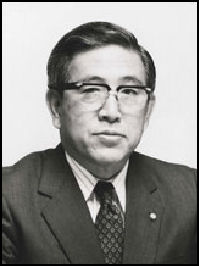
Shoichiro Toyoda Today the Toyoda family only holds about a 2 percent stake in Toyota but it remain influential, Many credit their presence with creating a unity not found in other companies.
Of the past 11 presidents, including the present one, six have come from the Toyoda family. After Tatsuro Toyoda stepped down from the post in 1995 due to poor health three non-family members — Hiroshi Okuda, Fujio Chu and Katsuaki Watanabe — assumed the president position.
Okuda was president from 1995 to 1999. He was replaced by Cho. The two men had almost a hundred year of work experience at Toyota between them.
Watanabe presided over Toyota duing a critical period of growth. He was listed 9th on the Fortune magazine list of the world’s 25 most powerful business leaders in 2007 and made the Time magazine list of “most influential people” in 2005 and 2007. On Toyota’s aim to be the world’s No. 1 car company in the world he said, “We’ll make the effort to achieve this lofty goal, while cautioning oneself not to become conceited or arrogant. “
Before Watanabe stepped down he was upbraided before 400 executives by 84-year-old honorary chairmen Shoichiro Toyoda, who said, “How many times have you made a mistake?” — a reference to Watanabe’s pursuit of making bigger profits with bigger cars as Detroit had done.
Akio Toyoda Takes Over as Toyota CEO in 2009
In June 2009, Akio Toyoda, a member of the founding family, was named president, replacing Watanabe. He is first Toyoda family member to serve as president in 14 years. Toyoda is the eldest son of Toyota Honorary Chairman Shoichiro Toyoda and is the great-grandson of Sakicho Toyoda, Toyota’s founder.
Akio Toyoda graduated from Keio University in 1979, received a degree in business administration from Babson College in Wellesley, Massachusetts, and worked for a U.S. investment firm before starting work at Toyota in 1984 when he was 27. After serving as vice president of a joint venture formed with General Motors he was picked to as a director of Toyota in 2000 at the age of 44. He became a Toyota vice president in June 2005 and was put in charge of the company’s overseas operations in June 2008.
When Toyoda took over Toyota, in the middle of the global financial crisis, a record number of shareholders showed up to hear what he was going to do to bring the company back to good health. In his first public news conference a day later he said he going to conduct a complete review of all of Toyota’s products and focus on which are best for each of its different regional markets. In a management reshuffle, executives that supported Toyota’s drive to build bigger more Detroit-like cars were ousted and replaced with executives that were more true to Toyota’s core employee- and customer-oriented values.
Akio Toyoda replaced half of Toyota’s directors, four of its five executive vice presidents and 18 of its 50 odd executive managing directors. Among those that went were some of his sharpest critics, leading some to call his accession to the top of Toyota a coup d’etat.
In December 2011, the Wall Street Journal picked Akio Toyoda, president of Toyota Motor Corp., as one of 12 Corporate Executives to Watch Next Year, saying that 2012 may be a "make or break year" for the chief of Japan's top automaker. "Is what's good for Japan good for Toyota and vice versa?" asked the paper, referring to Toyoda's vow to halt Japan's hollowing out and lift Toyota's low stock price. Among other executives named were Apple Inc.'s CEO Tim Cook, Cyrus Mistry, who is set to become chairman of Indian conglomerate Tata Group next year, and Fu Chengyu, chairman of Chinese petroleum and chemicals company Sinopec. [Source: Kyodo, December 31, 2011]
Toyota Executives and Management
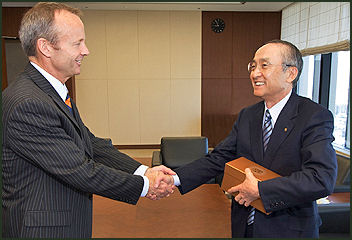
Akio Toyoda and the
Canadian Prime Minister In 2003, Toyota streamlined its dealerships and management system. It cut the number of board members from 58 to 30 and gave foreigners and younger people quicker promotions to senior positions.
In September 2007, Toyota’s top North American executive Jim Press left the company to move to Chrysler. As head of Toyota’s North American sales Press oversaw the company’s rapid expansion in the U.S. In 2006 he became the first non-Japanese North American president of Toyota. In 2007 he became the first non-Japanese board member. His move to Chrysler stunned the auto industry and was seen as a sign that Toyota was on the decline. Press had been with Toyota since 1970.
Honda and Toyota send new college-educated employees to work on assembly lines for several months after they are hired.
Toyota and the Future
Toyota is already the top automaker in the world. It aims to have 15 percent of global sales in 2010 and gain a 20 percent global market share in the not too distant future. Growth is projected to be in expanding in places where markets are growing — China. Russia and India — and developing next generation fuel savers like the Prius.
In September 2005 when oil prices were climbing to all time highs Toyota said that it might switch all of its vehicles over to hybrid engines. In 2006, Toyota said it aimed to significantly increase its output of hybrids by the early 2010s. Toyota has supplied Mazda with hybrid technology and hopes other companies will follow so the technology can become the global standard.
With the automobile industry becoming increasingly competitive, Toyota wants to increase its non-automobile sales to 10 percent for sales. Toyota is trying to break into pre-fab housing, traffic safety systems, light aircrafts engines and multimedia systems. Toyota is considering entering the aircraft industry with a tie-up with Mitsubishi Heavy Industries, Asia’s largest aerospace company, to build a 70 to 90 seat passenger jet.
In 2003, Toyota President Fujio Cho said the key to his company’s success in the future was to avoid “big company disease,” which he said is characterized by slowness to respond to inefficient processes and can be avoided by “putting people in competitive situations and encouraging them to continuously challenge themselves.”
Image Sources: 1) Toyota except 1940s cars and headquarters (Wkipedia) and Canadian Prime Minister (Canadian government)
Text Sources: New York Times, Washington Post, Los Angeles Times, Daily Yomiuri, Times of London, Japan National Tourist Organization (JNTO), National Geographic, The New Yorker, Time, Newsweek, Reuters, AP, Lonely Planet Guides, Compton’s Encyclopedia and various books and other publications.
Last updated October 2012
